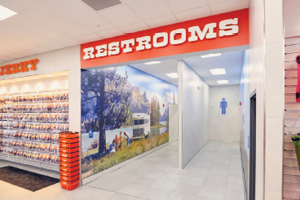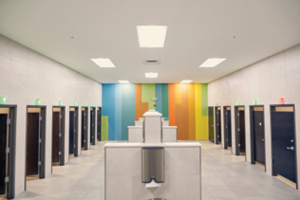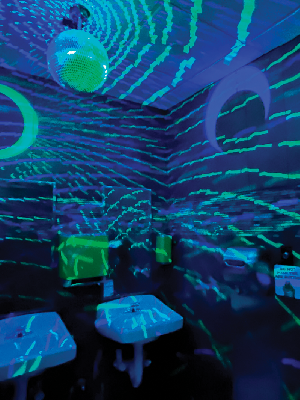Convenience stores are essential stops: They are the place to fuel up the car, grab a snack, stretch your legs and, of course, go to the bathroom. A clean bathroom is one of the most important aspects of a winning store—after all, everyone remembers a bad bathroom experience.
Texas-based Buc-ee’s wants customers to know it has “restrooms so clean, we leave mints in the urinals.” That’s one example of a billboard message that the retailer uses to draw attention to its restrooms. The marketing message continues to feed off itself as Buc-ee’s expands beyond its Texas-centric roots and each new location garners local media coverage with stories that talk about the brand’s massive footprint, beaver mascot—and bathrooms.
Back in 2012, bathroom supplier Cintas anointed Buc-ee’s New Braunfels bathroom “America’s Best Restroom.” The voting was still ongoing as of press time for the 2024 winner, but two convenience store brands are in the running: Utah-based Maverik and Kentucky-based Hop Shops, a 15-store retailer that rose to fame on TikTok and news media for its bathroom that invited patrons to push a button that turned the bathroom into a disco, complete with a disco ball, music and dance-club-like lighting.
Consumer-driven trends include a touch-free experience and a greater desire for privacy.
Bathroom Business
“Consumers associate clean restrooms with a well-run business,” said Jon Dommisse, vice president, business development and strategy for commercial washroom solutions company Bradley Company. “More and more of our data shows the bathroom is directly correlated to the full experience of the business.”
Of course, the opposite also holds true. “There is a direct correlation between an unclean restroom and the perception of a poorly managed business,” Dommisse said. “The store doesn’t even have to serve food on a plate in a restaurant-style setting. Any kind of food, including donuts in a bakery case—consumers do not want the food on-premises if there is an unclean bathroom.”
According to a 2024 NACS survey, more than one in four drivers (26%) say that they used the bathroom the last time they went inside the store, and that is often the pressing issue that takes priority over other behaviors. To break it down further, 24% of those who purchased gas and used the bathroom were male and 29% were female.
 Guests are greeted with a colorful mural as they walk into the restroom at Wally’s.
Guests are greeted with a colorful mural as they walk into the restroom at Wally’s.
The survey also found that more than half of all drivers (55%) say that they have a preference for a certain gas station—and 18% of these drivers said restrooms/cleanliness was the reason for their brand preference.
In essence, the bathroom door acts as a second front door for 26% of your store’s customers. Their experience in the restroom will play a large role in determining how much they will then spend. If you have a clean, well-managed facility, they will be much more open to trusting your food and beverages—especially prepared items.
The bathroom visit is a key part of the overall brand experience, Dommisse noted. According to Bradley Company’s 2024 Healthy Handwashing Survey, 62%, of U.S. consumers make it a point to stop at locations they report have good bathrooms.
What also jumps out in the survey results for Dommisse is the types of places where consumers said they were most concerned about germs: Stores moved to the No.1 place, climbing higher than healthcare settings for the first time. He credits the healthcare segment with doing a “phenomenal job” of making healthcare locations more hygienic and communicating this change to patients.
A Rising Focus on Experience
At Kentucky-based Hop Shops Convenience Stores, the retailer took customer experience to a whole new level in its bathrooms. The company installed disco bathrooms in six of its 15 stores.
Damon Bail, VP of retail operations and marketing at Hop Shops, said, “I wanted to create a type of ‘if you know, you know’ concept similar to speakeasies in our stores. And the bathroom is really important because one in five people who go into a convenience store use the restroom.”
“At Wally’s, the restrooms are one of our largest draws,” said Andy Strom, chief experience officer at the Midwestern retailer. “Typically, guests will come in, and that’s the first place they’ll go because they know it’s clean. Afterward, they’ll venture around the store, get some fresh food and do some shopping.”
 Wally’s restrooms combine functionality and personality, with bright colors and numerous stalls and touch-free appliances.
Wally’s restrooms combine functionality and personality, with bright colors and numerous stalls and touch-free appliances.
The brand’s locations are designed to be family friendly, and that extends into the restroom design. The restrooms feature a small commode just for kids, and there is a colorful accent wall along the back of the restroom—along with a mural on the entryway. “Our restrooms are designed to be an immersive, fun and extremely clean experience,” Strom noted.
“I think anyone, of any age, is looking for an experience.” Bail said. “What’s popular right now is having something interactive, or having something that adults can do that makes them feel like kids again,” he noted. “Kids of all ages love it, and we had an 84-year-old come out of the bathroom saying, ‘That was the best day of my life’ … At the end of the day, anytime you can do something different that impacts people of all ages, I think that matters.”
2024 Bathroom Design Expectations
What is acceptable to see in bathrooms today varies from pre-pandemic expectations. Dommisse goes as far to compare the change to what the iPod did for the music industry. “Covid is the one thing that forever changed public bathroom design,” he said. The emphasis today for operators is focused on easy-to-maintain surfaces—an advantage from a labor standpoint and cleanliness perspective, he said. Consumer-driven trends include a touch-free experience and a greater desire for privacy.
Touchless fixtures have become the expectation, Dommisse said. “Customers are tired of using paper towels or toilet paper over fixtures to turn on/off faucets,” he said. “They want everything automatic, as much as possible.”
Also gaining steam, a trend toward taller and lower stall partitions with absolutely no gap in the door hinge area. Add to that more unisex/family bathrooms. In addition to parents wanting that for small children, Dommisse pointed out the request now also comes from those tending to elderly parents, who desire more space to help someone in a stall.
Wally’s Strom said, “We want our guests to have an all-around nice, pleasant experience in the restroom.” Each stall is separated with full walls and doors that reach the ground, offering an extremely private space. The sinks have soap, water and drying features all in one fixture, making it a smooth experience for guests. The entire experience in the restroom is pretty much touch-free with guests, he noted.
 Hop Shops bathrooms have a special surprise for their guests—a personal disco.
Hop Shops bathrooms have a special surprise for their guests—a personal disco.
Functionality always leads when it comes to considering design and layout in bathroom spaces, said Paula Carr Wideman, interior designer and founder of spatial design company paulaproduct. “It has to function seamlessly, or what’s the point?” she said.
Functionality is a focus at Wally’s. “The restroom really is a priority for us. It’s a common conversation with our managers, and we’ll bring up the restrooms weekly in meetings, mostly because they’re used so much,” Strom said. “There’s always maintenance items. Our goal is to keep them operating smoothly and efficiently, so we go over anything that needs to be repaired, fixed, have a deeper clean and more.”
For materials, cleanable surfaces are a priority in retail restrooms, Wideman said, adding that porcelain tile is a workhorse. Elements like light fixtures offer a bit more room for creativity, as they do not require the same rigorous cleaning as the sink areas. Here she would consider if sconces might work to soften the space, along with adding some color or sheen.
Wideman noted that touchless facilities applies to almost all restrooms today in retail segments, stadiums, colleges, airports—large-volume facilities, adding that higher-end restaurants tend to lean more toward designing to feel like an extension of the home, and often that means moving away from touchless fixtures in favor of traditional components with handles.
“I like to think about how design interacts with the human experience,” Wideman said. “From the user’s standpoint, when they enter the space and feel like someone was helping them out, anticipated their needs, that makes them feel seen and want to come back.” Considerations that she points to that connect to this idea include more space in stalls to move around, a place for a smartphone and/or purse or bag, and more recently, even a tissue or towel along with a trashcan nearby so people using that to open the door after have a place to dispose of the tissue. “The foot-door pulls and things that rose in popularity around Covid do not seem to be lasting trends, but people are still using a towel or something to open the door after using a restroom, so it is yet another thing to consider.”
“Consumers associate clean restrooms with a well-run business.”
Hop Shops is currently in the process of designing and building three new sites in and around Owensboro, Kentucky, the birthplace of its parent company Valor Oil. Guests can expect state-of-the-art, modern and clean bathrooms, along with new disco bathroom sites. With the ground-up build, Bail hinted at potential innovation to come within the disco bathrooms—but nothing is official yet.
Overall, the bathroom should be an extension of the aesthetics of the business, Wideman said. “We want to continue the theme, and then add a surprise or delight for the user so people come out and say, have you seen the restroom?”
Cleanliness Above All Else
Every convenience store should be aware of the enhanced focus from consumers around cleanliness, Dommisse said. “The numbers are never going back to the pre-Covid-19 era,” he added, when the percentage of consumers who reported concern about germs was closer to 40%. Today more than 80% of respondents said they are highly conscious of being in contact with germs. “Heightened perceptions around germs continues,” Dommisse said. “And I don’t foresee that changing.”
Maintaining a high standard of cleanliness in all its bathrooms is of high priority for Hop Shops, Bail stated. The company has a process set up with a standard checklist, daily checklist and shift checklists. As staff clean, they mark that off their list, which is monitored by the district manager. Additionally, Hop Shops uses Cintas for a monthly deep clean. For the disco bathrooms, Bail noted that if anything breaks the maintenance department is automatically notified and sent to fix the issue.
At Wally’s, the restrooms have roughly 15 to 20 stalls in both the men’s and women’s bathrooms, along with another 13 to 15 urinals in the men’s room. “We have full-time restroom attendants. So each restroom is cleaned every hour on the clock,” Strom said.
Sparking Connection
One of the greatest successes of the disco bathroom is that it sparks connection for both the customer and the in-store employee, shared Damon Bail, VP of retail operations and marketing at Hop Shops. The bathrooms give the store employees something to talk about with the customer.
For example, Bail said, if a customer at the counter sees someone coming out of the bathroom giggling, they’re likely to strike up a conversation with the cashier, often along the lines of: “What’s so funny about the bathrooms?”
Bail said that his cashiers won’t tell customers about the disco experience, but instead encourage them to visit the bathroom the next time they come—assuring them that it’s clean and to not be afraid of the button.
Bail said interactions like this that have helped Hop Shops build its Ribbiting Rewards program. “Rewards cards are just like clean, fresh bathrooms, in that stores have to have them for retention and communication purposes, but our employees have really embraced them,” Bail explained. “Our employees find the stores with the disco bathrooms to be more fun and they really enjoy working there, and it translates into their conversations with customers.”
For more on Hop Shops and its disco bathrooms, check out Episode 429 of the Convenience Matters Podcast.